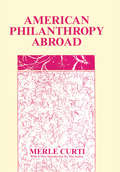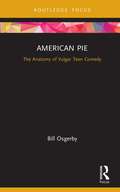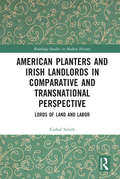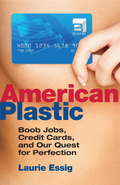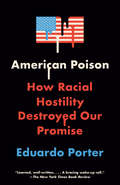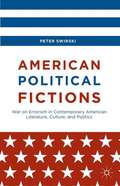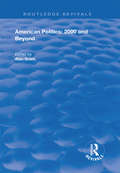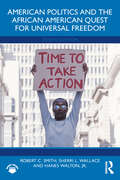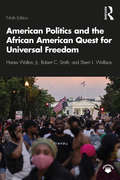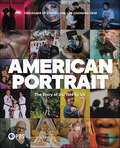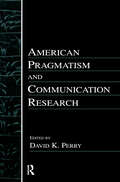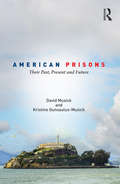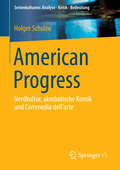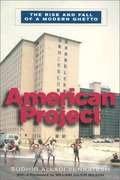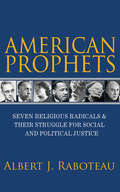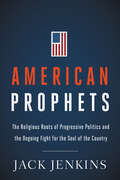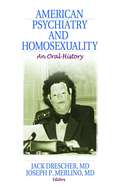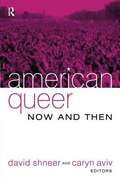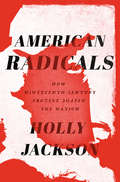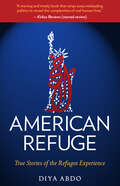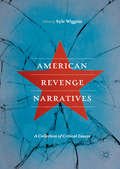- Table View
- List View
American Philanthropy Abroad
by Merle CurtiThis book tells for the first time, in rich detail, and without apologetics, what Americans have done, in the voluntary sector and often without official sanction, for human welfare in all parts of the world. Beneath the currently fashionable rhetoric of anti-colonialism is the story of people who have aided victims of natural disasters such as famines and earthquakes, and what they contributed to such agencies of cultural and social life as libraries, schools, and colleges.The work of an assortment of individuals, from missionaries to foundation executives, has advanced public health, international education, and technical assistance to the Third World. These people have also assisted in relief and relocation of refugees, displaced persons, and those who suffered religious and racial persecution. These activities were especially noteworthy following the two world wars of the twentieth century.The United States established great foundations—Carnegie, Rosenwald, Phelps-Stokes, Rockefeller, Ford, among others—which provided another face of capitalist accumulation to those in backward economic regions and those suffering political persecution. These were meshed with religious relief agencies of all denominations that also contributed to make possible what Arnold Toynbee called “a century in which civilized man made the benefits of progress available to all mankind.” This is a massive work requiring more than five years of research, drawing upon a wide array of hitherto unavailable materials and source documents.
American Philanthropy in Its Global Context: The History, Law, and Politics of Giving (Global Perspectives on Philanthropy and Public Good)
by Thomas AdamPhilanthropy has become a staple of American society and culture. Associations, endowments, foundations, and limited dividend companies have funded education, culture, healthcare, religion, and social welfare. Yet American philanthropy is not as exceptional as it appears to European observers. American philanthropy was built upon European and Mediterranean precedents and evolved through the constant influence of philanthropic practices in other parts of the world. This book explores how philanthropic practices and institutions were introduced into American society and how they were Americanised during the 19th century. It provides a comprehensive history of American philanthropy and positions it within its wider global context.
American Pie: The Anatomy of Vulgar Teen Comedy (Cinema and Youth Cultures)
by Bill OsgerbyAmerican Pie represents the most commercially successful example of the vulgar teen comedy, and this book analyses the film's development, audience-appeal and cultural significance. American Pie (1999) is a film that exemplifies that most disparaged of movie genres – the vulgar teen comedy. Largely aimed at young audiences, the vulgar teen comedy is characterised by a brazenly over-the-top humour rooted in the salacious, the scatological and the squirmingly tasteless. In this book, consideration is given to the relationship between American Pie’s success and broad shifts within both the youth market and the film business. Attention is also given to the film’s representations of youth, gender and sexuality, together with the distinctive character of its comedy and the enduring place of such humour in contemporary popular culture. While chiefly focusing on the original American Pie movie, the book also considers the development of the franchise, with discussion of the movie's three sequels and four direct-to-DVD releases. The book also charts the history, nature and appeal of vulgar teen comedy as a whole, providing the first concerted analysis of this generally overlooked category of youth film. Clear, concise and comprehensive, the book is ideal for students, scholars and general readership worldwide.
American Planters and Irish Landlords in Comparative and Transnational Perspective: Lords of Land and Labor (Routledge Studies in Modern History #77)
by Cathal SmithThis is the first study to systematically explore similarities, differences, and connections between the histories of American planters and Irish landlords. The book focuses primarily on the comparative and transnational investigation of an antebellum Mississippi planter named John A. Quitman (1799–1858) and a nineteenth-century Irish landlord named Robert Dillon, Lord Clonbrock (1807–93), examining their economic behaviors, ideologies, labor relations, and political histories. Locating Quitman and Clonbrock firmly within their wider local, national, and international contexts, American Planters and Irish Landlords in Comparative and Transnational Perspective argues that the two men were representative of specific but comparable manifestations of agrarian modernity, paternalism, and conservatism that became common among the landed elites who dominated economy, society, and politics in the antebellum American South and in nineteenth-century Ireland. It also demonstrates that American planters and Irish landlords were connected by myriad direct and indirect transnational links between their societies, including transatlantic intellectual cultures, mutual participation in global capitalism, and the mass migration of people from Ireland to the United States that occurred during the nineteenth century.
American Plastic
by Laurie EssigThe riveting story of how cosmetic surgery and plastic money melted together to create a subprime mortgage crisis of the body Plastic surgery has become "the answer" for many Americans, and in American Plastic sociologist Laurie Essig explores how we arrived at this particular solution. Over the last decade there has been a 465 percent increase in cosmetic work, and we now spend over $12 billion annually on procedures like liposuction, face-lifts, tummy tucks, and boob jobs. In this fascinating book, Essig argues that this transformation is the result of massive shifts in both our culture and our economy--a perfect storm of greed, desire, and technology. Plastic is crucial to who we are as Americans, Essig observes. We not only pioneered plastic money but lead the world in our willingness to use it. It's estimated that 30 percent of plastic surgery patients earn less than $30,000 a year; another 41 percent earn less than $60,000. And since the average cost of cosmetic work is $8,000, a staggering 85 percent of patients assume debt to get work done. Using plastic surgery as a lens on better understanding our society, Essig shows how access to credit, medical advances, and the pressures from an image- and youth-obsessed culture have led to an unprecedented desire to "fix" ourselves.
American Poison: How Racial Hostility Destroyed Our Promise
by Eduardo PorterA sweeping examination of how American racism has broken the country's social compact, eroded America's common goods, and damaged the lives of every American--and a heartfelt look at how these deep wounds might begin to heal.Compared to other industrialized nations, the United States is losing ground across nearly every indicator of social health. Its race problem, argues Eduardo Porter, is largely to blame.In American Poison, the New York Times veteran shows how racial animus has stunted the development of nearly every institution crucial for a healthy society, including organized labor, public education, and the social safety net. <P><P>The consequences are profound and are only growing graver with time. <P><P>Leading us through history and across America--from FDR's New Deal through Bill Clinton's welfare reform to Donald Trump's retrograde and divisive policies--Porter pieces together how racial hostility has blocked American social cohesion at every turn, producing a nation that fails not only its black and brown citizens but white Americans as well. American Poison is at once a broad, rigorous argument, and a profound cri de coeur. Even as it uncovers our most tenacious national pathology, it points the way toward hope, illuminating the ways in which, as the nation becomes increasingly diverse, it may well be possible to construct a new understanding of racial identity--and a more cohesive society on top of it.
American Political Fictions
by Peter SwirskiAmerican Political Fictions rewrites the book on American political art in a myth-busting study that ranges from historical 'faction' and apocalyptic thrillers to satirical fiction, rap poetry, TV'sThe West Wing, and not least the make-believe that streams out of the White House. It critically, not to say skeptically, sieves out historical facts from a sea of partisan and bipartisan disinformation in order to forge a more accurate picture of contemporary American culture and, through it, of America itself. In the process, it elucidates the ideological underpinnings, cultural manifestations, and democratic essence of contemporary political art - and of the partisan politics on which it feeds.
American Politics - 2000 and beyond: 2000 And Beyond (Routledge Revivals Ser.)
by Alan GrantThis title was first published in 2000: An examination of some of the key themes and issues central to the understanding of the contemporary political scene in the USA at the beginning of the 21st century. Bringing together the work of a number of academics with expertise in the field, it focuses on the state of American democracy and the working of the nation's governmental and political institutions. The topics covered include: American society and the politics of "Balkanisation"; party politics in Congress since the Republican takeover of control; presidential power and the experience of the Clinton presidency; the making of foreign policy; the office of independent counsel after the Starr report; the Rehnquist Supreme Court in a post-civil rights era; the influence of the Christian right; the Republican Party policy agenda; campaign finance reform; elections, voting behaviour and campaigning; and the reshaping of the federal system.
American Politics and the African American Quest for Universal Freedom
by Robert C. Smith Sherri L. Wallace Hanes Walton, Jr.American Politics and the African American Quest for Universal Freedom is known for its lucid style, student-oriented approach, and wide-ranging perspective. Designed to allow flexibility in teaching approaches, this tenth edition retains all the features that made previous editions so popular. All chapters have been updated with new content and the latest data available, including:• Inclusive and affirming language throughout.• Enhanced discussion on “Elements of Black Culture” and the political significance of African American music and the Black Church.• Black American public opinion and the various strands of African American ideology.• The CROWN Act, the politics of black hair, and the African American celebrity impact on politics.• Political significance of the increasing ethnic diversity of Black communities due to immigration from Africa and the Caribbean and the latest on “Black Lives Matter” discussion.• Discussion on the first Black sorority political action committee established in the U.S. and advocacy organizations serving the Black LGBTQIA+ community.• Characteristics of eligible and registered Black voters, the coverage of the 2024 presidential and congressional elections, and the results of the congressional elections with respect to partisan control of Congress and the size of the Black congressional delegation.• Demographic characteristics of the members of the 118th Congress now includes sexual orientation and generational data for comparison.• Race policies of former President Biden, reclassifying him as “antiracist.” An alternative method of ranking presidents that brings the views of Black experts to the conversation and includes a discussion of the record number of Black political appointments and policies implemented under Biden.• Confirmation hearing of the first Black woman, Justice Ketanji Brown Jackson, appointed to the Supreme Court. New material on the Voting Rights Act, Affirmative Action, and the Pigford cases testing institutional racism.• “Tennessee Three,” highlighting racism in the rare expulsion of two Black members of the Tennessee House of Representatives, and how Republican state-controlled legislatures are stunting the quest for universal freedom.• Revisions using the Urban League’s State of Black America “Equality Index,” as a measure of material well-being in the African American community, to examine historic and systemic patterns in structural inequities as manifested in economics, health, education, social justice, and civic engagement.• Updated Textbook Media Integration Guide featuring lecture power points, chapter summaries, critical thinking questions, the profiles and “Faces and Voices”, and the links to the biographical material and videos.American Politics and the African American Quest for Universal Freedom continues to offer a comprehensive, rigorous, and accessible understanding of how the presence of African Americans in the United States has profoundly influenced and influences American politics. It remains essential reading for all students of American Government, Black Politics, and African American Studies, particularly those approaching the study of race and politics for the first time.
American Politics and the African American Quest for Universal Freedom (Mysearchlab Series 15% Off Ser.)
by Robert C. Smith Sherri L. Wallace Hanes Walton, JrThis dynamic and comprehensive text from nationally renowned scholars continues to demonstrate the profound influence African Americans have had—and continue to have—on American politics. Using two interrelated themes—the idea of universal freedom and the concept of minority–majority coalitions—the text demonstrates how the presence of Africans in the United States affected the founding of the Republic and its political institutions and processes. The authors show that through the quest for their own freedom in the United States, African Americans have universalized and expanded the freedoms of all Americans. New to the Ninth Edition • Updated sections on intersectionality, dealing with issues of race and gender. • Updated section on African American music, to include the role of Hip Hop. • Updated sections on mass media coverage of African Americans and the African American Celebrity impact on politics, adding new mention of the CROWN Act and politics of Black hair. • Updated section on the "Black Lives Matter" movement, adding a new section on the "MeToo" movement. • Updated sections on African Americans in Congress, with a new mention of the Squad. • Updated voting behavior through the 2020 elections, connecting the Obama years with the new administration. • Provides a comparison of the 2016 and 2020 presidential elections. • Discusses the way in which race contributes to the polarization of American politics in the 2020 presidential campaign. • Provides an analysis of the racial attitudes of President Trump, and the institutionally racist policies of his administrations. • Updated chapter on state and local politics, including a new section on state executive offices and Black mayors. • Updated sections on material well-being indicators, adding a new section on the coronavirus pandemic and the Black community. • Provides the first overall assessment of the Obama administration in relation to domestic and foreign policy and racial politics.
American Portrait: The Story of Us, Told by Us
by PBSBased on the popular and revolutionary PBS multiplatform documentary project, an inspiring and striking photographic portrait that brilliantly captures the tumultuous, historic year that was 2020, offering an intimate look at the heart and soul of our national life and what it means to be an American today, revealed through the stories of ordinary people from sea to shining sea.Everyone has a story . . . In January 2020, in celebration of its 50th anniversary, PBS launched an ambitious national storytelling project, American Portrait, inviting people across the country to participate in a national conversation about what it means to be an American today. The multiplatform experience, including a television series that will air on PBS stations nationwide in January 2021, has created a communal voice through the individual stories of participants—each one a unique stitch in the beautiful, diverse quilt that is America. A vivid yet nuanced snapshot of who we are, this visually striking companion volume features more than 400 entries and photographs, all which began with an answer to a simple cue: My American story started when . . .You don’t know what it’s like to . . .My greatest challenge is . . . The tradition I carry on is . . . I was raised to believe . . . What keeps me up at night is . . .I took a risk when . . .When I step outside my door . . . Most days I feel . . . Told by people of all ages, orientations, and walks of life, these unique stories of joy, adversity, love, sacrifice, grief, sharing, triumph, and grace, centered on the themes of family, work, fun, faith, and community, illuminate the struggles, hopes, dreams, and convictions of Americans today. The more we share with our fellow citizens, the more we can see a real, complex, and fascinating representation of our country that is far richer and deeper than headlines and elections tell us. As intriguing, thoughtful, and distinct as the nation it embodies, American Portrait is a photographic manifestation of Walt Whitman’s immortal words, “I am large. I contain multitudes”—and a vital and ultimately hopeful reminder that what we all share is much greater and enduring than what may divide us.
American Post-Judaism: Identity and Renewal in a Postethnic Society (Religion in North America)
by Shaul MagidHow do American Jews identify as both Jewish and American? American Post-Judaism argues that Zionism and the Holocaust, two anchors of contemporary American Jewish identity, will no longer be centers of identity formation for future generations of American Jews. Shaul Magid articulates a new, post-ethnic American Jewishness. He discusses pragmatism and spirituality, monotheism and post-monotheism, Jesus, Jewish law, sainthood and self-realization, and the meaning of the Holocaust for those who have never known survivors. Magid presents Jewish Renewal as a movement that takes this radical cultural transition seriously in its strivings for a new era in Jewish thought and practice.
American Pragmatism and Communication Research (Routledge Communication Series)
by David K. PerryThis monograph examines the past, present, and potential relationship between American pragmatism and communication research. The contributors provide a bridge between communication studies and philosophy, subjects often developed somewhat in isolation from each other. Addressing topics, such as qualitative and quantitative research, ethics, media research, and feminist studies, the chapters in this volume: *discuss how a pragmatic, Darwinian approach to inquiry has guided and might further guide communication research; *advocate a functional view of communication, based on Dewey's mature notion of transaction; *articulate a pragmatist's aesthetics and connect it to Deweyan democracy; *discuss the similarities and differences between Dewey's notion of inquiry and the philosophical hermeneutics of Hans-Georg Gadamer; *apply accommodation theory, linked to symbolic interactionism and more generally to the social behaviorism of George H. Mead and his followers, to media research; *interpret media-effects evidence in light of pragmatist ideas about inquiry; and *argue that pragmatism theorizes about despair and life's sense of the tragic. This book is written to be readily accessible to students and professional academics within and outside the field of communication studies without extensive training in specialized areas of communication study.
American Prisons: Their Past, Present and Future
by David Musick Kristine Gunsaulus-MusickImprisonment has become big business in the United States. Using a "history of ideas" approach, this book examines the cultural underpinnings of prisons in the United States and explores how shared ideas about imprisonment evolve into a complex, loosely connected nationwide system of prisons that keeps enough persons to populate a small nation behind bars, razor wire and electrified fences. Tracing both the history of the prison and the very idea of imprisonment in the United States, this book provides students with a critical overview of American prisons and considers their past, their present and directions for the future. Topics covered include: • a history of imprisonment in America from 1600 to the present day; • the twentieth-century prison building binge; • the relationship between U.S. prisons and the private sector; • a critical account of capital punishment; • less-visible prison minorities, including women, children and the elderly; and • sex, violence and disease in prison. This comprehensive book is essential reading for advanced courses on corrections and correctional management and offers a compelling and provocative analysis of the realities of American penal culture from past to present. It is perfect reading for students of criminal justice, corrections, penology and the sociology of punishment.
American Progress: Nerdkultur, akrobatische Komik und Commedia dell'arte (Serienkulturen: Analyse – Kritik – Bedeutung)
by Holger SchulzeDie Serie 30Rock wälzt die medialen Erzählungen ihrer Epoche (und der Serie selbst) unaufhörlich um: in bislang sieben Staffeln, 140 Episoden, von 30 Autoren für 14 SchauspielerInnen geschrieben - rund um die Erfinderin und Hauptdarstellerin Tina Fey. Dieser Band untersucht die überdrehte Gegenwartsdystopie, ihre Erzählungen, Bühnen und Personen. Markante Episoden werden im Zusammenhang zeitgenössischer Pop- und TV-Kultur untersucht und einzelne ProtagonistInnen in ihrem medialen Handeln und dessen Referenzen. Ein Tableau der Medien- und der Nerdkultur sowie der politischen Agitation entsteht in Form von akrobatischer Komik und Celebrityobsession: eine Form der Commedia dell'arte über den American Progress.
American Project
by Sudhir Alladi VenkateshVenkatesh provides a captivating story on the rise and fall of a modern ghetto.
American Prophets: Seven Religious Radicals and Their Struggle for Social and Political Justice
by Albert J. RaboteauAmerican Prophets sheds critical new light on the lives and thought of seven major prophetic figures in twentieth-century America whose social activism was motivated by a deeply felt compassion for those suffering injustice.In this compelling and provocative book, acclaimed religious scholar Albert Raboteau tells the remarkable stories of Abraham Joshua Heschel, A. J. Muste, Dorothy Day, Howard Thurman, Thomas Merton, Martin Luther King, Jr., and Fannie Lou Hamer--inspired individuals who succeeded in conveying their vision to the broader public through writing, speaking, demonstrating, and organizing. Raboteau traces how their paths crossed and their lives intertwined, creating a network of committed activists who significantly changed the attitudes of several generations of Americans about contentious political issues such as war, racism, and poverty. Raboteau examines the influences that shaped their ideas and the surprising connections that linked them together. He discusses their theological and ethical positions, and describes the rhetorical and strategic methods these exemplars of modern prophecy used to persuade their fellow citizens to share their commitment to social change.A momentous scholarly achievement as well as a moving testimony to the human spirit, American Prophets represents a major contribution to the history of religion in American politics. This book is essential reading for anyone who is concerned about social justice, or who wants to know what prophetic thought and action can mean in today's world.
American Prophets: The Religious Roots of Progressive Politics and the Ongoing Fight for the Soul of the Country
by Jack Jenkins“[A] thoroughly reported [and] revelatory history about the intersection of progressive politics and religion in America” (Publishers Weekly).Since the 1970s, the Religious Right has established itself as a coalition of fundamentalist powerbrokers who set the standard for Christian political values. But, as religion reporter Jack Jenkins contends, the country is also driven by a vibrant, long-standing moral force from the left. Taking many forms and many names, the Religious Left has operated since America’s founding—praying, and protesting for progressive values such as abolition, labor reform, civil rights, environmental preservation.In American Prophets, Jenkins examines the re-emergence of progressive faith-based activism, detailing its origins and contrasting its goals with those of the Religious Right. Today’s rapidly expanding interfaith coalition — which includes Christians, Jews, Muslims, Buddhists, and other faiths — has become a force within the larger “resistance” movement. Jenkins profiles Washington political insiders—including former White House staffers and faith outreach directors for the campaigns of Barack Obama, John Kerry, and Hillary Clinton—as well as a new generation of progressive faith leaders, including:Linda Sarsour, co-chair of the Women’s MarchRev. Traci Blackmon, a pastor near Ferguson, Missouri, who lifts up black liberation efforts across the countrySister Simone Campbell, head of the Catholic social justice lobby and the “Nuns on the Bus” tour organizerNative American “water protectors” who demonstrated against the Dakota Access Pipeline in Standing RockBishop Gene Robinson, the first openly gay Episcopal bishop
American Psychiatry and Homosexuality: An Oral History
by Jack DrescherInterviews and first-hand accounts of an historic decision that affected the mental health profession—and American society and cultureThrough the personal accounts of those who were there, American Psychiatry and Homosexuality: An Oral History examines the 1973 decision by the American Psychiatric Association (APA) to remove homosexuality from its diagnostic and statistical manual of mental disorders (DSM). This unique book includes candid one-on-one interviews with key mental health professionals who played a role in the APA’s decision, those who helped organize gay, lesbian, and bisexual psychiatrists after the decision, and others who have made significant contributions in this area within the mental health field.American Psychiatry and Homosexuality presents an insider’s view of how homosexuality was removed from the DSM, the gradual organization of gay and lesbian psychiatrists within the APA, and the eventual formation of the APA-allied Association of Gay & Lesbian Psychiatrists (AGLP). The book profiles 17 individuals, both straight and gay, who made important contributions to organized psychiatry and the mental health needs of lesbian and gay patients, and illustrates the role that gay and lesbian psychiatrists would later play in the mental health field when they no longer had to hide their identities.Individuals profiled in American Psychiatry and Homosexuality include: Dr. John Fryer, who disguised his identity to speak before the APA’s annual meeting in 1972 on the discrimination gay psychiatrists faced in their own profession Dr. Charles Silverstein, who saw the diagnosis of homosexuality as a means of social control Dr. Lawrence Hartmann, who helped reform the APA and later served as its President in 1991-92 Dr. Robert J. Campbell, who helped persuade the APA’s Nomenclature Committee to hear scientific data presented by gay activists Dr. Judd Marmor, an early psychoanalytic critic of theories that pathologized homosexuality Dr. Robert Spitzer, who chaired the APA’s Nomenclature Committee Dr. Frank Rundle, who helped organize the first meeting of what would become the APA Caucus of Gay, Lesbian and Bisexual Psychiatrists Dr. David Kessler, AGLP President from 1980-82 Dr. Nanette Gartrell, a pioneer of feminist issues within the APA Dr. Stuart Nichols, President of the AGLP in 1983-84 and a founding member of the Gay and Lesbian Psychiatrists of New York (GLPNY) Dr. Emery Hetrick, a founding member of both AGLP and GLPNY Dr. Bertram Schaffner, who was instrumental in providing group psychotherapy for physicians with AIDS Dr. Martha Kirkpatrick, a long-time leader in psychiatry and psychoanalysis, both as a woman and an “out” lesbian Dr. Richard Isay, the first openly gay psychoanalyst in the American Psychoanalytic Association Dr. Richard Pillard, best known for studying the incidence of homosexuality in families of twins Dr. Edward Hanin, former Speaker of the APA Assembly Dr. Ralph Roughton, the first openly gay Training and Supervising Psychoanalyst to be recognized within the American and International Psychoanalytic AssociationsAmerican Psychiatry and Homosexuality presents the personal, behind-the-scenes accounts of a major historical event in psychiatry and medicine and of a decision that has affected society and culture ever since. This is an essential resource for mental health educators, supervisors, and professionals; historians; and LGBT readers in general.
American Pulp
by Paula Rabinowitz"There is real hope for a culture that makes it as easy to buy a book as it does a pack of cigarettes."--a civic leader quoted in a New American Library ad (1951)American Pulp tells the story of the midcentury golden age of pulp paperbacks and how they brought modernism to Main Street, democratized literature and ideas, spurred social mobility, and helped readers fashion new identities. Drawing on extensive original research, Paula Rabinowitz unearths the far-reaching political, social, and aesthetic impact of the pulps between the late 1930s and early 1960s.Published in vast numbers of titles, available everywhere, and sometimes selling in the millions, pulps were throwaway objects accessible to anyone with a quarter. Conventionally associated with romance, crime, and science fiction, the pulps in fact came in every genre and subject. American Pulp tells how these books ingeniously repackaged highbrow fiction and nonfiction for a mass audience, drawing in readers of every kind with promises of entertainment, enlightenment, and titillation. Focusing on important episodes in pulp history, Rabinowitz looks at the wide-ranging effects of free paperbacks distributed to World War II servicemen and women; how pulps prompted important censorship and First Amendment cases; how some gay women read pulp lesbian novels as how-to-dress manuals; the unlikely appearance in pulp science fiction of early representations of the Holocaust; how writers and artists appropriated pulp as a literary and visual style; and much more. Examining their often-lurid packaging as well as their content, American Pulp is richly illustrated with reproductions of dozens of pulp paperback covers, many in color.A fascinating cultural history, American Pulp will change the way we look at these ephemeral yet enduringly intriguing books.Some images inside the book are unavailable due to digital copyright restrictions.
American Queer, Now and Then
by David Shneer Caryn AvivContrasting queer life today and in years past, this landmark book brings together autobiographies, poetry, film studies, maps, documents, laws, and other texts to explore the meaning and practice of the word "queer". By this Shneer and Aviv mean:queer as both a form of social violence and a call to political activism; queer as played by Robin Williams and Sharon Stone and as lived by Matthew Shepard and Brandon Teena; queer in the courthouses of Washington D.C. and on the streets of hometown America. Contextualizing these contemporary stories with ones from the past, and understanding them through the analytic tools of feminist social criticism and history, the authors show what it means to be queer in America. queer [adj: 1. differing from what is usual or ordinary; odd; singular; strange 2. slightly ill 3. mentally unbalanced 4. counterfeit; not genuine 5. homosexual: in general usage, still chiefly a slang term of contempt or derision, but lately used by some as a descriptive term without negative connotations --Webster's Dictionary. queer [adj: used to describe a 1. body of theory 2. field of critical inquiry 3. way of proudly identifying a group of people 4. way of seeing the world 5. sense of difference from the norm --David Shneer and Caryn Aviv, American Queer, Now and Then.
American Radicals: How Nineteenth-Century Protest Shaped the Nation
by Holly JacksonA dynamic, timely history of nineteenth-century activists—free-lovers and socialists, abolitionists and vigilantes—and the social revolution they sparked in the turbulent Civil War era“In the tradition of Howard Zinn’s people’s histories, American Radicals reveals a forgotten yet inspiring past.”—Megan Marshall, Pulitzer Prize–winning author of Margaret Fuller: A New American Life and Elizabeth Bishop: A Miracle for Breakfast On July 4, 1826, as Americans lit firecrackers to celebrate the country’s fiftieth birthday, both John Adams and Thomas Jefferson were on their deathbeds. They would leave behind a groundbreaking political system and a growing economy—as well as the glaring inequalities that had undermined the American experiment from its beginning. The young nation had outlived the men who made it, but could it survive intensifying divisions over the very meaning of the land of the free? A new network of dissent—connecting firebrands and agitators on pastoral communes, in urban mobs, and in genteel parlors across the nation—vowed to finish the revolution they claimed the Founding Fathers had only begun. They were men and women, black and white, fiercely devoted to causes that pitted them against mainstream America even while they fought to preserve the nation’s founding ideals: the brilliant heiress Frances Wright, whose shocking critiques of religion and the institution of marriage led to calls for her arrest; the radical Bostonian William Lloyd Garrison, whose commitment to nonviolence would be tested as the conflict over slavery pushed the nation to its breaking point; the Philadelphia businessman James Forten, who presided over the first mass political protest of free African Americans; Marx Lazarus, a vegan from Alabama whose calls for sexual liberation masked a dark secret; black nationalist Martin Delany, the would-be founding father of a West African colony who secretly supported John Brown’s treasonous raid on Harpers Ferry—only to ally himself with Southern Confederates after the Civil War. Though largely forgotten today, these figures were enormously influential in the pivotal period flanking the war, their lives and work entwined with reformers like Frederick Douglass, Elizabeth Cady Stanton, and Henry David Thoreau, as well as iconic leaders like Abraham Lincoln. Jackson writes them back into the story of the nation’s most formative and perilous era in all their heroism, outlandishness, and tragic shortcomings. The result is a surprising, panoramic work of narrative history, one that offers important lessons for today.
American Refuge: True Stories of the Refugee Experience (Truth to Power)
by Diya Abdo&“A moving and timely book that strips away misleading politics to reveal the complexities of real human lives." — Kirkus Reviews (starred review)A provocative, conversation-sparking exploration of refugee experiences told in their own words, for readers of Karla Cornejo Villavicencio&’s The Undocumented Americans and Viet Thanh NguyenForced to leave their homes, they came to America...In this intimate and eye-opening book, Diya Abdo--daughter of refugees, U.S. immigrant, English professor, and activist—shares the stories of seven refugees. Coming from around the world, they&’re welcomed by Every Campus A Refuge (ECAR), an organization Diya founded to leverage existing resources at colleges to provide temporary shelter to refugee families.Bookended by Diya&’s powerful essay "Radical Hospitality" and the inspiring coda &“Names and Numbers,&” each chapter weaves the individual stories into a powerful journey along a common theme: Life Before (&“The Body Leaves its Soul Behind&”) The Moment of Rupture (&“Proof and Persecution&”) The Journey (&“Right Next Door&”) Arrival/Resettlement (&“Back to the Margins&”) A Few Years Later (&“From Camp to Campus&”) The lives explored in American Refuge include the artist who, before he created the illustration on the cover of this book, narrowly escaped two assassination attempts in Iraq and now works at Tyson cutting chicken.We learn that these refugees from Burma, Burundi, Iraq, Palestine, Syria, and Uganda lived in homes they loved, left against their will, moved to countries without access or rights, and were among the 1% of the "lucky" few to resettle after a long wait, almost certain never to return to the homes they never wanted to leave. We learn that anybody, at any time, can become a refugee.
American Representations of Post-Communism: Television, Travel Sites, and Post-Cold War Narratives (Routledge Research in Cultural and Media Studies)
by Andaluna BorcilaWith the televised events of 1989, territories of Eastern and Central Europe that had been marked as impenetrable and inaccessible to the Western gaze exploded into visibility. As the narratives of the Cold War crumbled, new narratives emerged and new geographies were produced on and by American television. Using an understudied archive of American news broadcasts, and tracing their flashes and echoes through travel guides and narratives of return written by Eastern European-Americans, this book explores American ways of seeing and mapping communism’s disintegration and the narratives articulated around post-communist sites and subjects.
American Revenge Narratives: A Collection of Critical Essays
by Kyle WigginsAmerican Revenge Narratives critically examines the nation’s vengeful storytelling tradition. With essays on late twentieth and twenty-first century fiction, film, and television, it maps the coordinates of the revenge genre’s contemporary reinvention across American culture. By surveying American revenge narratives, this book measures how contemporary payback plots appraise the nation’s political, social, and economic inequities. The volume’s essays collectively make the case that retribution is a defining theme of post-war American culture and an artistic vehicle for critique. In another sense, this book presents a scholarly coming to terms with the nation’s love for vengeance. By investigating recent iterations of an ancient genre, contributors explore how the revenge narrative evolves and thrives within American literary and filmic imagination. Taken together, the book’s diverse chapters attempt to understand American culture’s seemingly inexhaustible production of vengeful tales.
